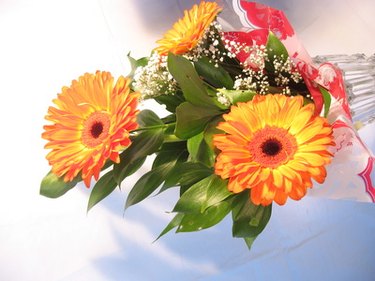
The diversity apparent within the plant kingdom is brought about by sexual reproduction among the species, much like in the human population. Combined gene traits from two parents produce a modified version of their combined gene pool. These reproductive abilities produce genetic variations through recombined genetic materials, making plants adaptable and able to evolve into stronger, more viable organisms.
Sexual Reproduction
Video of the Day
Just as with humans, the plant world requires both male and female parts in order for sexual reproduction to take place. The plants that don't have these parts must reproduce through an asexual process. Flowering plants--also known as angiosperms--carry male and female parts inside their flowers, according to the Oracle ThinkQuest Education Foundation. Colorful flowers are designed to attract insects that assist in the reproduction process. Flowers that lack color rely on wind currents to assist instead. Female structures include the ovary, style and stigma, while the filament and anther make up the male structures.
Video of the Day
Alternation of Generations
The alternation of generations is a reproductive cycle that includes both sexual and asexual reproduction in plants, according to the Oracle ThinkQuest Education Foundation. This cycle occurs only in certain types of plants, such as mosses and ferns. The asexual process uses spores in one generation of plants. The next generation consists of gametes, or male and female sex cells that sexually reproduce another generation of spores. The alternation of generations cycle is a limiting factor in terms of diversity potential when compared with the sexual reproductive process found in flowers.
Seeds
The sexual reproduction process produces seeds, or zygotes, when male and female cells combine, according to the Encyclopedia Britannica. The resulting seed has half of the chromosomes from each parent cell. The creation of a new cell from a male and female cell is called meiosis. The new seed then undergoes multiple cell divisions that eventually develop into a new plant body. This cell division process is called mitosis. The resulting plant body houses a new variation of gene traits that will combine with the gene traits of another plant. These processes account for the multiple varieties of flowering plant species in existence.
Pollination
Pollination is the process through which the female parts of a plant are fertilized by the male parts of another plant. The filament and anther structures that make up the male parts of a plant produce the pollen that acts as a fertilizer material, according to the Oracle ThinkQuest Education Foundation. The female parts–stigma, style and ovary--house the eggs that will be pollinated once pollen comes into contact with them. Both insects and wind currents take part in this pollination process, according to the Encyclopedia Britannica. Insects are attracted to colorful flowers and their nectars, and carry around pollen particles as they move from plant to plant. Wind currents work to blow pollen particles from plant to plant.
Conifers
Conifers are plants that carry their reproductive parts on the scales of their cones, according to the Encyclopedia Britannica. Shrubs and trees make up most of this species. The male sex cells reside in pollen particles that form inside small male cones. The female sex cells are contained inside eggs that sit on female cones. Wind currents work to blow pollen particles into the air, many of which fall to the ground. The ones that don't fall to the ground find their way to the female cones of other plants and begin the reproductive process from there.